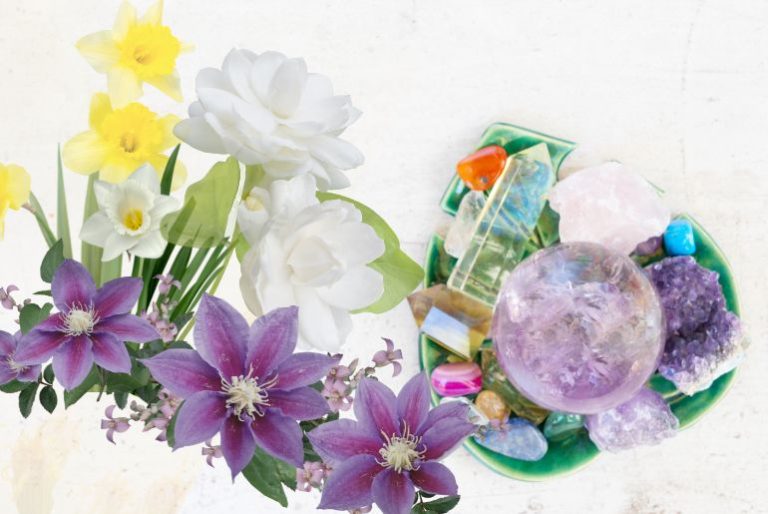Have you ever wondered what your baby’s birthstone or your baby’s birth flower is? We’ve compiled a complete overview of every birthstone, both traditional and modern, as well as every birth flower, for each month of the year.
Each month of the year has it’s own birthstone, as well as a birth flower. Over time the birthstones have been adjusted, and we’ve been sure to compile both the ‘traditional’ birthstone as well as the ‘modern’ birthstone to cover this anomaly.
Many people enjoy using the gemstone or the flower of a particular month as part of a birthday gift for loved ones. They make especially loved baby shower gifts.
This is a beautiful tradition that can make for a very special gift, with a deep meaning. Of course, you don’t have to stick to the table below, but there is something anchoring knowing that a certain gemstone from the Earth can represent the month in which you were born.
Below the table we’ve compiled a complete overview for each month of the year. Beneath each month’s listing you’ll find an overview of the associated gemstone and birth flower, as well as what the birthstone represents, and the meaning behind the birth flower. These symbols makes the birthstone and birth flower even more special.
If you’re here because you have a baby on the way, then you may also be looking for a name for your baby. Be sure to check out our baby names and meanings for boys or our baby names and meanings for girls articles.
Birthstones and Birth Flowers
The table below outlines the modern and traditional birthstones for each month, as well as the associated birth flower.
| Birth Month | Birthstone Modern | Birthstone Traditional | Birth Flower |
|---|---|---|---|
| January | Garnet | Garnet | Carnation |
| February | Amethyst | Amethyst | Violet |
| March | Aquamarine | Bloodstone | Daffodil |
| April | Diamond | Diamond | Daisy |
| May | Emerald | Emerald | Sunflower |
| June | Alexandrite | Pearl | Rose, Honeysuckle |
| July | Ruby | Ruby | Larkspur |
| August | Peridot | Sardonyx | Lily, Gladiolus |
| September | Sapphire | Sapphire | Forget-Me-Not, Morning Glory |
| October | Tourmaline | Opal | Marigold, Camellia |
| November | Golden Topaz | Topaz | Chrysanthemum |
| December | Blue Zircon | Turquoise | Holly, Narcissus |
Now that you have an overview of the whole year, you can check out the meanings of birthstones, and the meanings of birth flowers, for each individual month of the year.
Birthstones for January – Modern, Traditional and Birth flowers
Modern birthstone: Garnet
Traditional birthstone: Garnet
Birth flower for January: Carnation
Meaning of January Birthstone: The garnet is a precious stone consisting of a deep red vitreous silicate mineral. Although traditionally red, the garnet also comes in red, green, purple, yellow and orange. Garnet is said to be the stone of love, loyalty and friendship. It’s also known as the commitment stone and said to ensure the safe return of a friend of loved one.
Meaning of January Birth flower: The carnation is often a double-flowered cultivated variety of clove pink, with grey-green leaves and showy pink, white, or red flowers. The carnation is said to represent fascination, distinction and love. While red carnations signify love, pink are said to mean gratitude and white for purity and luck.
Birthstones for February – Modern, Traditional and Birth flowers
Modern birthstone: Amethyst
Traditional birthstone: Amethyst
Birth flower for February: Violet
Meaning of February Birthstone: The amethyst is a semi-precious stone type of silicate mineral quartz. Although quartz appears in a wide range of colours, amethyst quartz comes in mauve through violet to deep purple gradients. Amethyst was once the choice of stones for Cardinals and Royalty. It’s name, from ancient greek, means ‘not intoxicated’ and amethyst is said to be grounding and to protect against toxicity and toxic thoughts.
Meaning of February Birth flower: Violets have been cultivated since 500BC and are said to have medicinal qualities. Wild violets usually have 5 petals per flower, with a white to yellow centre, and vibrant mauve to violet colouring. Violets are said to represent innocence, wisdom and mental clarity.
Birthstones for March – Modern, Traditional and Birth flowers
Modern birthstone: Aquamarine
Traditional birthstone: Bloodstone
Birth flower for March: Daffodil
Meaning of March Birthstone: Aquamarine is a common gemstone and a variety of beryl. With hues from pale blue to light green and even a deep blue variant and often few inclusions, aquamarine makes a beautiful gem for jewellery. Obviously connected with the sea, in ancient times aquamarine was thought to protect people at sea. Aquamarine also represents courage, calmness and everlasting youth.
Meaning of March Birth flower: The daffodil is a spring flowering bulb with a brilliant yellow or white flower and yellow to orange centre, atop a long green stem. Daffodil’s typically appear in early spring and bring a bright pop of colour after a long, grey winter. The daffodil represents rebirth and new beginnings, as well as forgiveness and wellness.
Birthstones for April – Modern, Traditional and Birth flowers
Modern birthstone: Diamond
Traditional birthstone: Diamond
Birth flower for April: Daisy
Meaning of April Birthstone: The diamond is a solid, crystal form of the element carbon. Diamonds are one of the hardest materials on Earth and developed over 1 billion year’s ago, very deep down in the Earth’s mantle, under extreme heat and pressure. Traditionally clear, diamonds also come in blue, yellow, green pink and red and are highly sought after for their refractive quality. The diamond represents purity, pure insight, unity and love.
Meaning of April Birth flower: The daisy is a delightful European grassland flower belonging to the Aster family. Daisy’s have a bright yellow centre with a ray of up to 30 petals surrounding it. The classic daisy is white with a yellow centre, but other varieties come with white and yellow petals, fully yellow and even pink. The daisy represents purity, innocence, beauty and fertility.
Birthstones for May – Modern, Traditional and Birth flowers
Modern birthstone: Emerald
Traditional birthstone: Emerald
Birth flower for February: Sunflower
Meaning of May Birthstone: Emeralds are one of the four ‘precious’ gemstones, and a variety of beryl. Most emeralds are green, but they can come in hues of yellow and blue too. Emeralds typically have many inclusions, which gives them their mossy, green appearance, with pure emeralds being very rare. The emerald represents truth and love, youth and hope, and is also said to be a stone of luck.
Meaning of May Birth flower: The common sunflower is an annual herb from the daisy family. Sunflowers can grow up to 4 meters tall and have a ray of bright yellow petals around a yellowish-brown centre. Sunflower seeds are often used in cooking. Sunflowers also come in miniature varieties and with petals in bright orange through red, to deep crimson, and even pink. Sunflowers symbolize happiness and optimism, loyalty and adoration.
Birthstones for June – Modern, Traditional and Birth flowers
Modern birthstone: Alexandrite
Traditional birthstone: Pearl
Birth flower for June: Rose, Honeysuckle
Meaning of June Birthstone: Alexandrite is a semi-preciousl gemstone and a type of chrysoberyl. Often referred to as ’emerald by day, ruby by night’, Alexandrite has the unique quality of changing colour in different light. This beautiful stone appears blueish-green in day light, and under artificial light in the evening appears purplish-red. Alexandrite symbolizes good fortune, luck, and prosperity and is believed to bring balance in times of change.
Meaning of June Birth flower: The rose is a woody perennial flowering plant, often with spiky stems, with tens of thousands of different hybrids. Blooms have multiple, soft lush petals, which are often fragrant. Colours range from white through yellow to red, pink through crimson and of course red. Revered around the world, the rose has influenced culture, art, literature and fashion. The rose represents friendship, gratitude, romance and love.
Birthstones for July – Modern, Traditional and Birth flowers
Modern birthstone: Ruby
Traditional birthstone: Ruby
Birth flower for July: Larkspur
Meaning of July Birthstone: Ruby is one of the four ‘precious’ gemstones, and a type of mineral corundum. Rubys come in hues from light pinkish to deep ruby-red. Stones typically have many inclusions and are the third hardest gemstones. The ruby gemstone is very sought after and traditional for cardinals and royalty alike. The ruby represents nobility and purity, love, energy, passion and power.
Meaning of July Birth flower: The larkspur is an annual flowering plant in the buttercup family. Larkspurs have spikes of spurred, fluffy flowers, and are related to delphiniums. The blooms come in an array of colours from white through yellow, pink and red, and even crimson through blue. The larkspur represents an open heart and a strong bond of love and affection.
Birthstones for August – Modern, Traditional and Birth flowers
Modern birthstone: Periodot
Traditional birthstone: Sardonyx
Birth flower for August: Lily, Gladiolus
Meaning of August Birthstone: The peridot is a gemstone in the olivine family and is rich in magnesium. Peridots have the unique quality among gemstones of only occurring in one colour. They come in a deep yellowish-green to emerald-green hue. They are also only one of two gemstones that develop not in the Earth’s crust, but in the upper-mantel lava layer. The peridot is known to bring health and restful sleep, as well as prosperity and good fortune.
Meaning of August Birth flower: Lillies are tall perennials that form from a bulb. often with large, fragrant flowers. The summer blooming flowers come in many colours from the traditional white lily, as well as oranges, pinks, reds, yellows and purples. They make an excellent cut flower and due to their popularity lilies have influenced art and culture around the world. The lily signifies purity, virtue and innocence, as well as rejuvenation and abundance.
Birthstones for September – Modern, Traditional and Birth flowers
Modern birthstone: Sapphire
Traditional birthstone: Sapphire
Birth flower for September: Forget-Me-Not, Morning Glory
Meaning of September Birthstone: Sapphires are one of the four ‘precious’ gemstones, and a type of mineral corundum. Sapphires come in iridescent shades of deep blue, but also in hues of yellow, orange and green, and are the third hardest gemstones. The sapphire is highly sought after and it’s deep blue colour is associated with royalty. Sapphires represent nobility, innocence and truth and are said to calm the mind and bring abundance.
Meaning of September Birth flower: The true forget-me-not grows on tall, hairy stems, with delicate, five-petaled flowers and yellow centres. The clusters of flowers range from pink through to royal-blue, and this self-seeding wildflower is often used in border gardens. The forget-me-not represents remembrance, devotion and eternal love.
Birthstones for October – Modern, Traditional and Birth flowers
Modern birthstone: Tourmaline
Traditional birthstone: Opal
Birth flower for October: Marigold, Camellia
Meaning of October Birthstone: Tourmaline is a semi-precious boron silicate gemstone. Tourmaline makes great jewellery and comes in more colour combinations than any other gem. From black to brownish, orange-red to yellow, and violet-blue to pink hues, tourmaline also come in bi-colour and tri-colour stones, as well as rare neon-green and electric-blue. Tourmaline is said to be the stone of reconciliation and it fosters compassion and cool-headedness.
Meaning of October Birth flower: Marigolds are annual herbs of the aster family. Typically bright orange or yellow, marigolds also come in bright reds and multi-colour hybrids. With bright clusters of pom-pom like flowers that bloom over a long season, marigolds are found in many border gardens. Marigolds symbolize positive emotion and energy, as well as passion, creativity and happiness.
Birthstones for November – Modern, Traditional and Birth flowers
Modern birthstone: Golden Topaz
Traditional birthstone: Topaz
Birth flower for November: Chrysanthemum
Meaning of November Birthstone: Golden topaz is a semi-precious silicate mineral gemstone. It’s a sought after stone, especially in India, and makes beautiful jewellery. Traditionally yellow, topaz also comes in colourless and blue and rare forms of pink, red and golden-orange. Golden topaz represents empathy and serenity and boosts confidence and generosity. It’s also said to inspire confidence and pride, without inflating the ego.
Meaning of November Birth flower: Chrysanthemum are flowering plants in the aster family, with lush, pom-pom like blooms in a dizzying amount of colours, Chrysanthemum dry very well and are sought after in floral arrangements. Hybrid colours include pinks to violets, mauve to purple, yellowy-whites to orange, greens and peaches, and more. Chrysanthemum represent longevity, rebirth and joy, as well as happiness and wellbeing.
Birthstones for December – Modern, Traditional and Birth flowers
Modern birthstone: Blue Zircon
Traditional birthstone: Turquoise
Birth flower for December: Holly, Narcissus
Meaning of December Birthstone: Blue zircon is a semi-precious silicate mineral and a source of the metal zirconium. Zircon is typically brown in it’s natural form, and a simple heat treatment turns the stones transparent to pale blue, through ocean blue. It’s a relatively hard stone, and makes great jewellery. Blue zircon symbolizes strength of will and courage, and is said to help build relationships and self-confidence.
Meaning of December Birth flower: Holly is an evergreen shrub, typically with dark green, spiky leaves, small white flowers, and bright red berries. The holly was adopted as a symbol of Jesus Christ’s crown of thorns, and so is strongly associated with Christmas. Holly symbolizes fertility, peace and goodwill, and is said to remind us of our own inner strength and endurance.
Modern Birthstones and Birthflowers Chart
Click on the chart to download a printable version:
Now that you know your baby’s birthstone and birthflower, check out the rest of our expert articles in our Babies section.

































this is nice. i can use this info 4 my grls 2nd birfday
Flowers are northern hemisphere view, so seasons are opposite for us down here. Example Daffodils (spring flower) not available for us in March.
I am born in March when daffodils will not available.